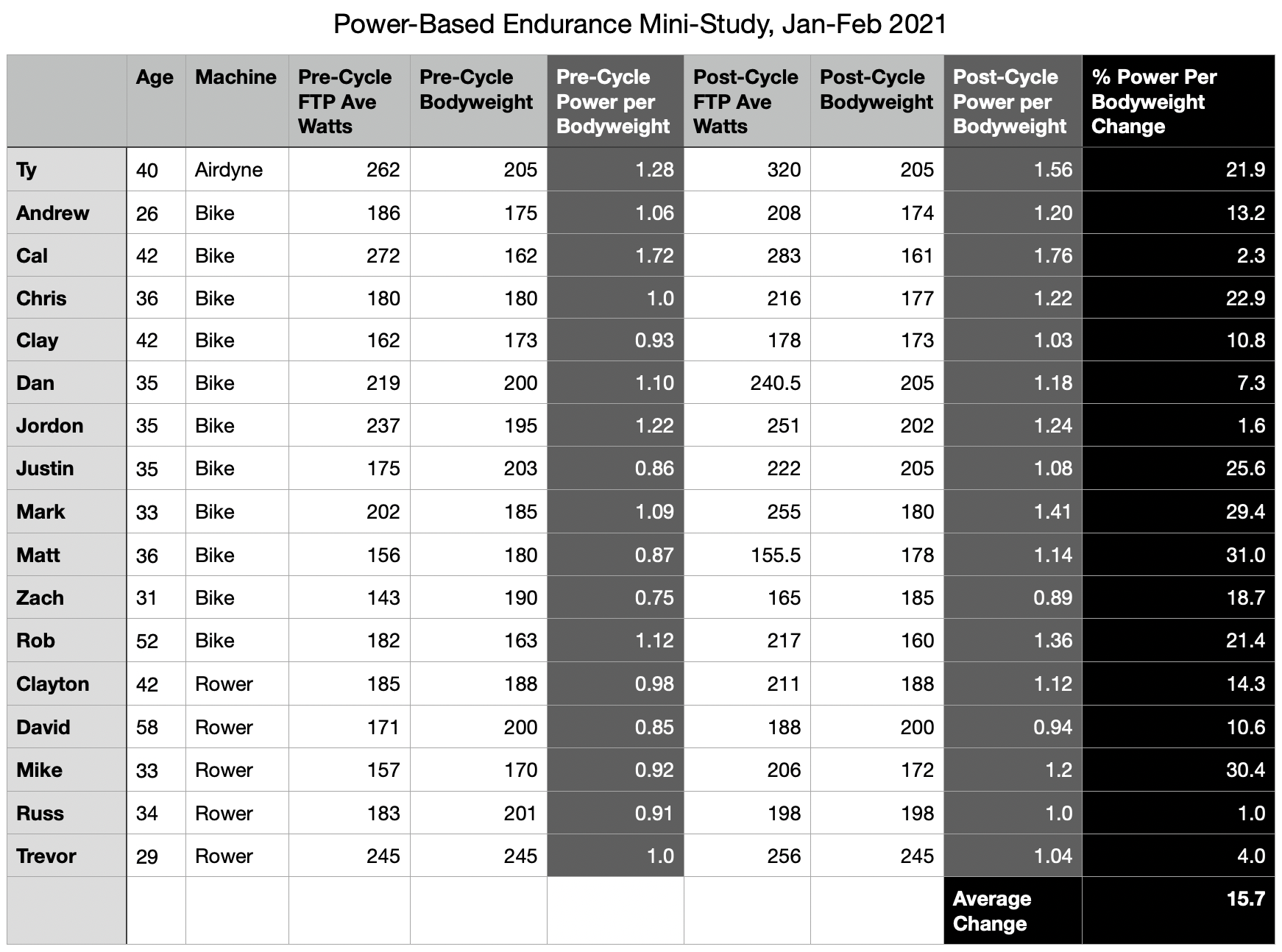By Rob Shaul, Founder
BLUF
Three and a half weeks of MTI power-based endurance programming increased power per bodyweight an average of 15.7%.
Background and Study Design
Until this mini-study, a significant part of MTI endurance programming is pace-based. The athlete will complete a run, ruck, row or swim assessment, and follow-on intervals will be based on the athlete’s assessment pace. This system has proven very effective to improve endurance speed-over-ground performance.
This mini-study applied MTI’s pace-based programming to power, and measured the results.
Modern spin bikes, rowing ergs, and assault bikes can measure power, both in terms of total kilojoules produced, as well as current power output in watts.
Seventeen remote lab rats completed a 3.5-week endurance training cycle on spin bikes, rowing ergs and assault bikes using power as a means of measurement and progression, rather than pace.
All lab rats will completed the same, 3-day/week programming. Below was the weekly schedule:
- Monday: 30-Minute FTP Assessment or Threshold Intervals
- Tuesday: No Bike/Row Training
- Wednesday: Threshold Intervals
- Thursday: No Bike/Row Training
- Friday: 60-75 Minute Moderate Pace Bike/Row
Three times during the cycle, at the beginning of the training week, the lab rats completed a 30-minute “Functional Threshold Power” (FTP) assessment. Their most recent FTP was used to calculate intensity for 10-minute threshold intervals and longer, 60-75 minute moderate paced efforts.
The initial and last FTP assessments, and the athletes’ current bodyweight, were used to calculate “Power per Bodyweight” and the pre-cycle and post-cycle power per bodyweight calculations were compared.
Results and Discussion
A total of 17 individuals completed the entire training 3.5 week cycle. Below are the individual lab rat results.
To get the “Power per Bodyweight” score, we divided the FTP average wattage by the athlete’s bodyweight. For example, my post-cycle FTP was 217 watts (this was the average power output I managed over the 30-minute assessment). Dividing this FTP (217 watts) by my bodyweight (160 pounds) yielded a post-cycle Power per Bodyweight score of 1.36.
The “Power per Bodyweight” is also a way to normalize power production between athletes of various bodyweights. However, in this study, it would be wrong to assume that the athletes with the highest power per bodyweight scores are the most fit. Why? – because of the differences between machines. Making direct comparisons like this would only work if we were all using the same machine.
As well, it would be wrong to assume that a FTP score on one machine or mode will transfer to another machine or mode – bike to rower, for example.
To make this point, Lab Rat Trevor used a rower for the study and scored a post-cycle FTP of 256 watts. I asked him to rest a day, and complete a 30-minute FTP test on an assault bike. He scored 286 watts on the assault bike.
While the average Power per Bodyweight improvement for this mini-study was 15.7%, individual improvement ranged from a low of 1% to a high of 31%. Part of this wide range of improvement could be caused by lack of familiarity with the machine the athlete used for the study, and or power-based training. There’s no doubt that a portion of the improvement many of the lab rats saw was caused not because of an increase in fitnesss, but rather familiarity with the machine they were training on, and/or the 30-minute FTP assessment itself.
But regardless, the 16.1% average power per bodyweight change found in this study matches the 10-20% improvement we have seen in the past using our pace-based programming for running and rucking, ultimately demonstrating that MTI’s endurance programming approach also works using power as a unit of measurement.
Next Steps?
One of the advantages of power as a unit of measurement is it eliminates the impact of the elements. For example, wind, heat and elevation gain/loss can significantly impact biking, running, and rucking pace from one assessment to the next. So pace-based programming can be impacted not necessarily by the athlete’s actual fitness, but by how windy is was on assessment day.
Power output is not impacted by these environmental issues, and thus can lead to more consistent and trackable progression. This is one of it’s advantages.
More specifically to this study, a handful of the lab rats reported difficulty making the prescribed threshold intervals following the Week 2 FTP assessment. As designed, lab rats completed the 30-minute FTP assessment the Monday of Week 1, 2 and 4. We re-assessed on week 2 knowing that the lab rats would be more familiar with the machine they were using as well as the FTP assessment itself, and this early in the cycle re-assessment would lead to a more accurate assessment of actual FTP.
From a programming perspective, this means the threshold interval progression we use for pace-based programming may be too aggressive for power-based programming. More study is likely tweaking the programming to find what is appropriate and doable.
Questions? Email rob@mtntactical.com
Comments? Please comment below.
You Might Also Like MTI’s 357 Strength Training Plan


